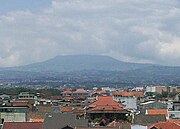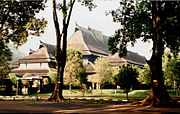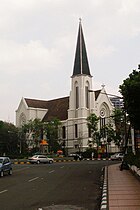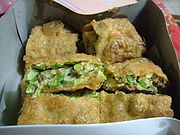Maluku Islands
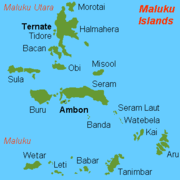 | |
| Geography | |
|---|---|
 | |
| Location | South East Asia |
| Coordinates | 3°9′S 129°23′E / 3.15°S 129.383°E / -3.15; 129.383 |
| Total islands | ~1000 |
| Major islands | Halmahera, Seram, Buru, Ambon, Ternate, Tidore, Aru Islands, Kai Islands |
| Area | 74,505 km² |
| Highest point | Binaiya (3,027 m) |
| Country | |
| Indonesia | |
| Provinces | Maluku, North Maluku |
| Demographics | |
| Population | 1,895,000 (as of 2000) |
| Ethnic groups | Nuaulu, Manusela |

The Maluku Islands (also known as the Moluccas, Moluccan Islands, the Spice Islands) are an archipelago in Indonesia, and part of the larger Maritime Southeast Asia region. Tectonically they are located on the Halmahera Plate within the Molucca Sea Collision Zone. Geographically they are located east of Sulawesi (Celebes), west of New Guinea, and north of Timor. The islands were also historically known as the "Spice Islands" by the Chinese and Europeans, but this term has also been applied to other islands.
Most of the islands are mountainous, some with active volcanoes, and enjoy a wet climate. The vegetation of the small and narrow islands, encompassed by the sea, is very luxuriant; including rainforests, sago, rice and the famous spices - nutmeg, cloves and mace, among others. Though originally Melanesian, many island populations, especially in the Banda Islands, were killed in the 17th century. A second influx of Austronesian immigrants began in the early 20th century under the Dutch and continued in the Indonesian era.
Politically, the Maluku Islands formed a single province from 1950 until 1999. In 1999 the North Maluku (Maluku Utara) and Halmahera Tengah (Central Halmahera) regency were split off as a separate province, so the islands are now divided between two provinces, Maluku and North Maluku. Between 1999 and 2002 they were known for religious conflicts between Muslims and Christians but have been peaceful in the past years.
Spice Islands most commonly refer to the Maluku Islands (formerly the Moluccas), which lie on the equator, between Sulawesi (Celebes) and New Guinea in what is now Indonesia, and often specifically to the small volcanic Banda Islands, once the only source of mace and nutmeg.
The term has also been used less commonly in reference to other islands known for their spice production, notably the Zanzibar Archipelago off East Africa consisting of Unguja, Mafia and Pemba. These islands were formerly the independent state of Zanzibar but now form a semi-autonomous part of Tanzania.
Geography
The Maluku Islands are often described by tourist literature as having 999 islands; they are 90% sea with 77,990 km2 of land, and 776,500 km2 of sea.
- Ternate, main island
- Bacan
- Halmahera - at 20,000 km2 is the largest of the Maluku Islands.[3]
- Morotai
- Obi Islands
- Sula Islands
- Tidore
- Ambon Island, main island
- Aru Islands
- Babar Islands
- Banda Islands
- Buru
- Kai Islands
- Kisar
- Leti Islands
- Seram
- Tanimbar Islands
- Wetar
Etymology
The name Maluku is thought to have been derived from the Arab trader's term for the region, Jazirat al-Muluk ('the island of the kings').
History
Background: "The Spice Islands"
The native Bandanese people traded spices with other Asian nations, such as China, since at least the time of the Roman Empire. With the rise of Islam, the trade became dominated by Muslim traders. One ancient Arabic source appears to know the location of the islands, describing them as fifteen days' sail East from the 'island of Jaba' - presumably Java[citation needed] — but direct evidence of Islam in the archipelago occurs only in the late 1300s, as China's interest in regional maritime dominance waned. With Arabic traders came not just Islam, but a new technique of social organisation, the sultanate, which replaced local councils of rich men (orang kaya) on the more important islands, and proved more effective in dealing with outsiders. (See Ternate & Tidore).
By trading with Muslim merchants, Venice came to monopolise the spice trade in Europe between 1200 and 1500, through its dominance over Mediterranean seaways to ports such as Alexandria, after traditional overland connections were disrupted by Mongols and Turks. The financial incentive to discover an alternative to Venice's monopoly control of this lucrative business was perhaps the single most important factor precipitating Europe's Age of Exploration. Portugal took an early lead charting the route around the southern tip of Africa, securing various bases en route, even discovering the coast of Brazil in the search for favourable southerly currents. Portugal's eventual success and the establishment of its own empire provoked the other maritime powers in Europe—Spain (see Ferdinand Magellan), France, England and the Netherlands—to challenge and overcome the Portuguese position.
Because of the high value that the spices had in Europe and the large incomes that it produced, the Dutch and British were soon involved in conflicts to try to gain a monopoly over the region. The fighting for control over these small islands became very intense with the Dutch even giving the island of Manhattan to the British in exchange for, among other things, a small island that gave the Dutch full control over the Banda archipelago. The Bandanese people lost the most in the fighting with most of the people being either slaughtered or enslaved by the Dutch. Over 6,000 were killed during the Spice Wars.
The goal of reaching the Spice Islands, eventually to be enveloped by the Dutch East Indies Empire, led to the accidental discovery of the West Indies, and lit the fuse of centuries of rivalry between European maritime powers for control of lucrative global markets and resources. The tattered mystique of the Spice Islands finally died when France and Britain successfully smuggled seeds and plants to their own dominions on Mauritius, Grenada and elsewhere, making spices a more commonplace and affordable commodity.
Early history
The earliest archaeological evidence of human occupation of the region is about thirty-two thousand years old, but evidence of even older settlements in Australia may mean that Maluku had earlier visitors. Evidence of increasingly long-distance trading relationships and of more frequent occupation of many islands, begins about ten to fifteen thousand years later. Onyx beads and segments of silver plate used as currency on the Indian subcontinent around 200BC have been unearthed on some of the islands. In addition, local dialects employ derivations of the Malay word then in use for 'silver', in contrast to the term used in wider Melanesian society, which has etymological roots in Chinese, a consequence of the regional trade with China that developed in the 500s and 600s.
Maluku was a cosmopolitan society where spice traders from across the region took residence in settlements, or in nearby enclaves, including Arab and Chinese traders who visited or lived in the region.
The Portuguese
Apart from some relative inconsequential cultural influences, the most significant lasting effects of the Portuguese presence was the disruption and disorganisation of Asian trade, and in eastern Indonesia—including Maluku—the planting of Christianity. The Portuguese had conquered Malacca in the early sixteenth century and their lasting influence was most strongly felt in Maluku and other parts of eastern Indonesia. Following the Portuguese conquest of Malacca in August 1511, Afonso de Albuquerque learned the route to the Banda Islands and other 'Spice Islands', and sent an exploratory expedition of three vessels under the command of António de Abreu, Simão Afonso Bisigudo and Francisco Serrão. On the way to return, Francisco Serrão was shipwrecked at Hitu island (northern Ambon) in 1512. There he established ties with the local ruler who was impressed with his martial skills. The rulers of the competing island states of Ternate and Tidore also sought Portuguese assistance and the Portuguese were welcomed in the area as buyers of food and spices during a lull in the spice trade due to a temporary disruption to Javanese and Malay sailings to the area following the 1511 conflicts in Malacca. The Asian trade soon revived and the Portuguese were never able to dominate the trade.
Allying himself with Ternate, Serrão constructed a fortress on the island and served as the head of a mercenary band of Portuguese warriors under the service of one of two feuding powerful sultans who controlled the spice trade. Such an outpost far from Europe generally only attracted the most desperate and avaricious, such that the feeble attempts at Christianisation, strained relations with Ternate's Muslim ruler. Serrão urged Ferdinand Magellan to join him in Maluku, and gave the explorer information about the Spice Islands. Both Serrão and Magellan, however, perished before they could meet one another. In 1535 King Tabariji was deposed and sent to Goa by the Portuguese. He converted to Christianity and changed his name to Dom Manuel. After being declared innocent of the charges against him he was sent back to reassume his throne, but he died en route in Malacca in 1545. He had, however, bequeathed the island of Ambon to his Portuguese godfather Jordão de Freitas. Following the murder of Sultan Hairun at the hands of the Portuguese, the Ternateans expelled the Portuguese in 1575 after a five-year siege.
The Portuguese first landed in Ambon in 1513, but it became the new centre for Portuguese activities in Maluku following their expulsion from Ternate. European power in the region was weak and Ternate became an expanding, fiercely Islamic and anti-Portuguese state under the rule of Sultan Baab Ullah (r. 1570 - 1583) and his son Sultan Said. The Portuguese in Ambon, however, were regularly attacked from native Muslims on the island's northern coast, in particular Hitu, which had trading and religious links with major port cities on Java's north coast. Indeed, the Portuguese never managed to control the local trade in spices, and failed in attempts to establish their authority over the Banda Islands, the nearby centre of nutmeg production.
Following Portuguese missionary work, there have been large Christian communities in eastern Indonesia through to contemporary times, which has contributed to a sense of shared interest with Europeans, particularly among the Ambonese. By the 1560s there were 10,000 Catholics in the area, mostly on Ambon, and by the 1590s there were 50,000 to 60,000, although most of the region surrounding Ambon remained Muslim.The Spaniard Francis Xavier also played an important role in Maluku Christianization (see next section).
Other Portuguese influences include a large number of Indonesian words derived from Portuguese which alongside Malay was the lingua franca up until the early nineteenth century. Contemporary Indonesian words such as pesta ('party'), sabun ('soap'), bendera ('flag'), meja ('table'), Minggu ('Sunday'), all derive from Portuguese. Many family names in Maluku are derived from Portuguese including De lima, Waas, da Costa, Dias, de Fretas, Gonsalves, Mendoza, Rodrigues, and da Silva. Also of part-Portuguese origin are the romantic keroncong ballads sung to a guitar.











